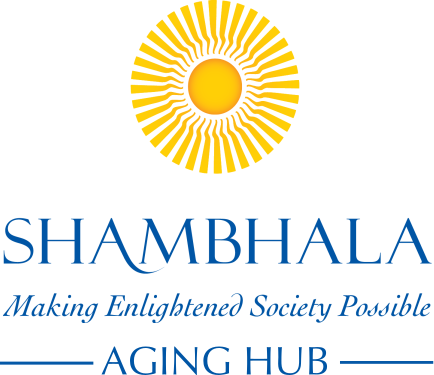About the Working Group and its History
The Shambhala Working Group on Aging was formed in 2008 at the inspiration of then president, Richard Reoch, and the Sakyong’s Council.
In 2009, the Working Group, with David Whitehorn as chair, issued a Statement identifying six points from which the Group would work to “build an enlightened response to the inevitable process of aging.” David Whitehorn summarized the Statement saying, “being older offers both (1) a rich opportunity for practice and contribution to creating enlightened society, and (2) challenges and needs for support arising from illness, disability or financial difficulties.”
Statement on Aging in Shambhala
- The inherent nature of mind, basic goodness, being unconditional, does not change with age. No matter how old or infirm we may become, basic goodness remains fully intact.
- Rather than viewing aging as leading to the fixation of long standing habitual patterns, with mind training (meditation practice), as we grow older there is the opportunity for mind to become more open and less fixed.
- Physical and mental capacities inevitably decline with increasing age.
- In Shambhala we can simultaneously recognize both the opportunity to be more openly engaged with the world as we grow older, and the inevitable decline in physical and mental capacities, culminating in death.
- In this context, ‘conventional’ retirement is a misguided myth. The idea that as we age we can ‘retire’ from the world and become less engaged is not consistent with Shambhala vision. Quite to the contrary, as our responsibilities and time commitment for family and livelihood decrease we can devote more time and energy to building enlightened society, as well as to our personal practices. This is ‘enlightened’ retirement.
- As we age many of us will, at some point, experience physical ailments that will make it difficult, or perhaps impossible, for us to care for ourselves. At those times, other members of Shambhala society need to be positioned to come forward to be sure that what we are unable to do for ourselves is done.
In 2009, the Working Group recommended that each Shambhala center form its own aging group, to be supported by the international Working Group on Aging. Ann Cason and Jack Bodner, with the generous support of The Shambhala Trust, surveyed all Shambhala centers in 2014 to determine their aging-related needs. It became clear that very few centers had formal aging groups or care teams. Many survey respondents felt that whatever needs were being addressed represented only the “tip of the iceberg.” The survey indicated that while our community is certainly conversant with the reality of aging and death, the very idea of aging brings up fear. For many the subject is preferably ignored. See that report, titled “Leadership Voices: Report on the Aging in Shambhala Survey” for more detail.
It was clear that a shift was needed in the understanding of what it means to be aging within the context of Shambhala. To that end, the Working Group created the Aging Hub in 2016 to provide resources and support for all aspects of aging, as well as resources for starting aging groups. The Hub is one of the Working Group’s core tools and responsibilities.
Other recent offerings originating from the Working Group on Aging include the “Aging Series” of live online talks, “Rites of Passage,” a Facilitator’s Guide for conducting discussion groups (salons) on aging, and frequent “Aging in Enlightened Society” articles in the Shambhala Times.
The Working Group on Aging is composed of volunteers who are committed individually and collectively to the long-term viability of the Working Group and the Aging Hub. It falls under the auspices of the Director of the Office of Societal Health and Well-being.
Current members of the Working Group and their bios are listed here.
